#warsaw ghetto uprising
Text
80th Anniversary of the Warsaw Ghetto Uprising: "The World Has to Know That We Did Not Go Like Lambs to the Slaughter."
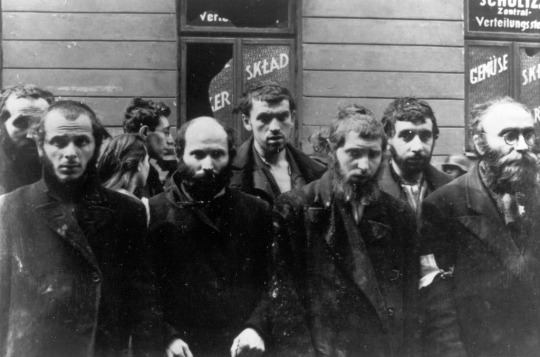


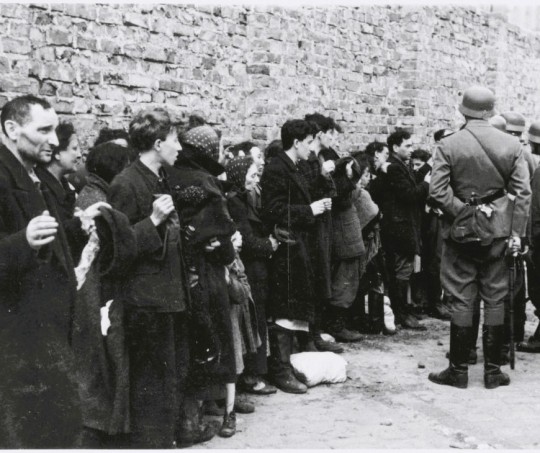
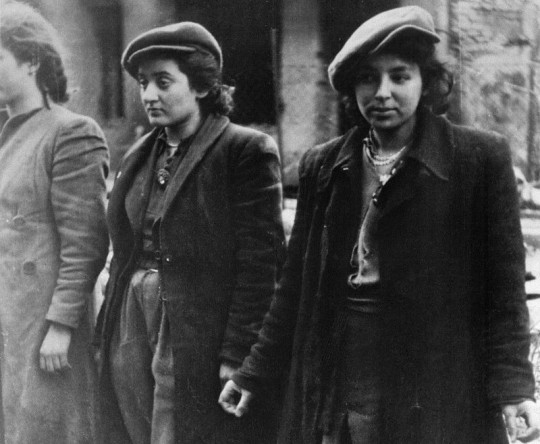
April 19th, 1943 - May 16th, 1943
Warsaw, Poland
“The question is not why all the Jews did not fight, but how so many of them did. Tormented, beaten, starved, where did they find the strength, spiritual and physical, to resist?” – Elie Wiesel
In the morning of April 19th, 1943, on what would be the first night of Passover, the Warsaw Ghetto Uprising began. German troops and SS entered the ghetto to deport its surviving inhabitants to the death camps.
In the summer of 1942, as Jews living in the Warsaw ghetto were deported to Treblinka, reports that made their way back quickly made it clear that "resettlement" meant mass-murder. In response to this, Jews citizens in the ghetto began forming organized resistance forces; the Jewish Combat Organization (ŻOB) and the Jewish Military Union (ŻZW).
Following the January 1943 success of a smaller-scale resistance preventing a deportation attempt, an act that led to the suspension of such deportation efforts by the Nazis, the residents began to secretly build subterranean tunnels and shelters in preparation for a full-scale uprising.
Throughout April rumours swirled of a final deportation of the ghetto's remaining Jews. On the 18th it became clear that German forces, reinforced with artillery and tanks, were moving in to carry out their final action. The alarm was raised, and residents retreated to their underground shelters. They would remain here for the duration of the uprising, refusing to surrender themselves to deportation.
A group of around 700 Jewish resistance fighters, made up of the ŻOB and ŻZW and led by 24-year-old Mordechai Anilevitch, joined together to stage what would be their final stand against the Nazis. These brave young people were malnourished and lacked proper military training, they were equipped with nothing but poor-quality or even homemade weapons and their bare hands.
By contrast German forces numbered 2000, they were well-equipped and well-trained and had advanced knowledge of the existence of these resistance groups.
Despite this stark imbalance, on the first day of the uprising the ragtag Jewish fighters met the invaders head on and successfully forced the Nazis to retreat outside the city walls.
Amongst all of the chaos and destruction all around them, the Jews hiding in the tunnels and bunkers gathered together to celebrate Passover with what little they had, breaking homecooked matzah and drinking illicitly obtained wine.
The Warsaw Ghetto Uprising held strong for a full 27 days, coming to an end on May 16th, 1943. Unable to gain a full advantage, the Germans had resorted to burning the Warsaw Ghetto to the ground in an attempt flush out those in hiding so they could be rounded up.
In the months following the official end of the uprising some Jews remained hiding out in the rubble, periodically attacking German police on patrol.
This was the largest uprising by Jews during World War II and the first significant urban revolt against German occupation in Europe. It inspired many more uprisings, especially amongst Jews in camps and Ghettos.
May Their Memories Be a Revolution
Learn More:
Warsaw Ghetto Uprising | Holocaust Encyclopedia
Holocaust Survivors Describe the Last Passover in the Warsaw Ghetto
Tuesday, Nissan 27, 5783 / April 18, 2023 - Jewish Calendar - On This Day
#jumblr#jewish#judaism#yom hashoah#holocaust remembrance day#the shoah#shoah#shoah remembrance day#holocaust#the holocaust#shoah mention#holocaust mention#antisemitism#antisemitism tw#tw antisemitism#jewish history#nazi tw#warsaw#warsaw ghetto#warsaw ghetto uprising#may their memories be a blessing#may their memories be a revolution#a few days early
2K notes
·
View notes
Text
On May Day, May 1, 1943, surviving fighters in the Warsaw Ghetto, most of whom were varying stripes of Socialist, sang The International. One of Jewish commanders, Marek Edelman, wrote about it in his memoir:
“On May Day, the Command decided to carry out a ‘holiday’ action. Several battle groups were sent out to ‘hunt down’ the greatest number of Germans possible. In the evening, a May Day roll-call was held. The partisans were briefly addressed by a few people and the ‘Internationale’ was sung. The entire world, we knew, was celebrating May Day on that day and everywhere forceful, meaningful words were being spoken. But never yet had the ‘Internationale’ been sung in conditions so different, so tragic, in a place where an entire nation had been and was still perishing. The words and the song echoed from the charred ruins and were, at that particular time, an indication that Socialist youth was still fighting in the Ghetto, and that even in the face of death they were not abandoning their ideals.”
He didn't include anything regarding the language they sang in, but Edelman was a member of the Bund, and they were staunch Yiddishists, so I'd like to think it sounded like this:
youtube
197 notes
·
View notes
Text




#free palestine#palestine#israel#gaza#free gaza#genocide#zionism#anti zionisim#marek edelman#warsaw ghetto uprising
69 notes
·
View notes
Text
please watch the WHOLE vid!!
What a Jewish Uprising against Germans teaches us about Palestine.
instagram
more about/for Palestine in this post:

instagram


#palestinians#save palestine#palestine#free palestine#free gaza#gaza genocide#palestinian genocide#genocide#ethnic cleansing#gaza strip#save gaza#gazaunderattack#gaza#israel#ceasefire#warsaw ghetto#warsaw ghetto uprising#jewish uprising#Instagram
88 notes
·
View notes
Text
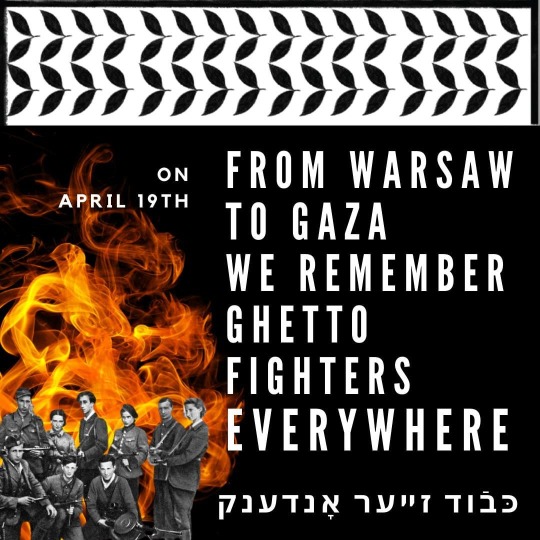
From the @loudjewcollective:
81 years ago, on April 19th, Jews who were trapped in the Warsaw ghetto rose up in an epic act of armed resistance against the Nazi forces.
כּבֿוד זײער אָנדענק
Koved zeyer ondenk - we honour their memory.
We know that the young Jews who took up arms were not terrorists - just like Palestinians in Gaza, they were the terrorised.
Jews in the ghetto faced constant death, hunger and humiliation, they were terrorised and declared un-human by the occupying Germans. But many were determined to fight back - they smuggled in and home made weapons. They knew that resistance is life and collaboration is death.
We know Gaza is another ghetto - more than half the population are refugees, who were forced to move there when they were driven from their lands in other parts of Palestine. Israel controls everything in Gaza - how much food people have, the right to movement and who lives and dies - in the last 6 months they have slaughtered over 34,000 Palestinians as the world has watched. Just as the world watched while Germans rounded up and killed Jews, Roma people, queers and leftists.
In 1943, Jews militantly resisted the Nazi occupation under which their lives were made unlivable - just as the Palestinian people have resisted since 1948 and are resisting today in Gaza. Zionists are scared of this comparison because they want to claim that Israel is an eternal victim. But we know they are supporting a program of ethnic cleansing not that different to what Nazi Germany enacted.
We honour the resistance fighters, the survivors, those who endure.
This image is of Jewish fighters from Vilnus - Jewish uprisings erupted in five major cities, 45 provincial towns, 5 major concentration and extermination camps, as well as in at least 18 forced labor camps.
#free palestine#warsaw#warsaw ghetto uprising#warsaw uprising#human rights#Holocaust#Shoah#palestine#gaza#israel#jewish history#jewish antizionism#antizionist jews#antizionism#resistance#solidarity#jews for palestine#jews for ceasefire#jumblr
32 notes
·
View notes
Text
Right now I'm reading a book about female fighters in Warsaw ghetto uprising and it enrages me that we know so little about them. There's so little sources describing them. Why? Because they were always pictured merely as men's companions. As if only males were the real heroes, while the women were only there to help them by doing some less important things. And when there was a woman who was willing to fight and die and was so brave, then she was described as "man-like". It's ridiculous. But I'm glad that women in history are slowly getting their autonomy back.
#the book is called kwestia charakteru bojowniczki z getta warszawskiego in polish#idk if it's translated to english#women in history#jewish#jewish women#heroines#female fighters#female soldiers#herstory#warsaw ghetto#warsaw ghetto uprising#shoah#holocaust#ww2#radfem#radical feminism#radfem safe#radblr#radfems do interact#feminism#radfems do touch#women's rights#women's liberation#jumblr#mine
115 notes
·
View notes
Text
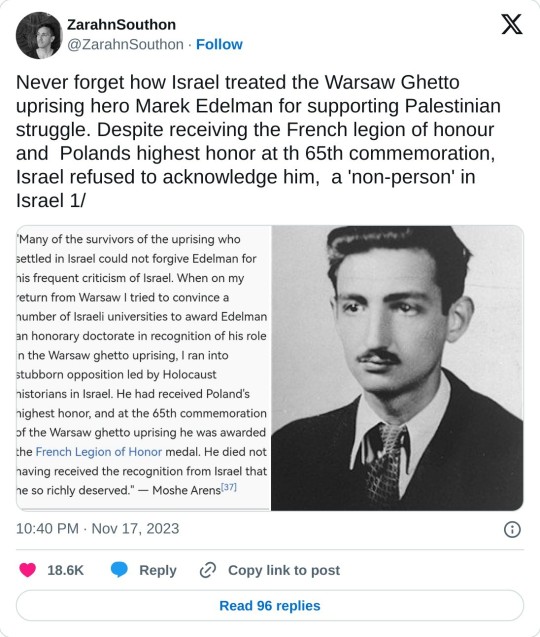
32 notes
·
View notes
Text
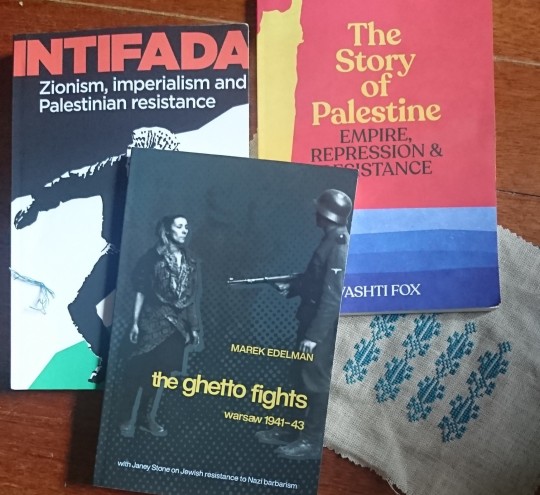
Current reading:
The Story of Palestine: Empire Repression & Resistance, Vashti Fox
Intofada: Zionism Imperialism and Palestinian Resistance, Phil Marshall
The Ghetto Fights: Warsaw 1941-43, Mark Edelman
available through Red Flag books.
Edelman famously would not leave Poland, wrote an open letter to Palestinian fighters voicing advice (highly critical of suicide bombing) and support, equating their causes.
His short work on the Warsaw Ghetto uprising is essential reading, including how much it relates to Palestine and Gaza. There is a direct line here: Jews of Warsaw had every right to resist. Palestinians have every right to resist.
I do not believe in any States-self-appointed-claim that it is only for [insert narrowly defined invented-historical] people. Third Reich 'only for Aryan' had no right to exist. South Africa 'only for whites' had no right to exist. Israel 'only for [white presenting] Jews has no right to exist.
We are not free until all of us are free.
#palestine#gaza#west bank#Marek Edelman#Warsaw Ghetto Uprising#solidarity#from the river to the sea#genocide#always was always will be#Apartheid#free gaza#Ceasefire now#Free Palestine
20 notes
·
View notes
Photo

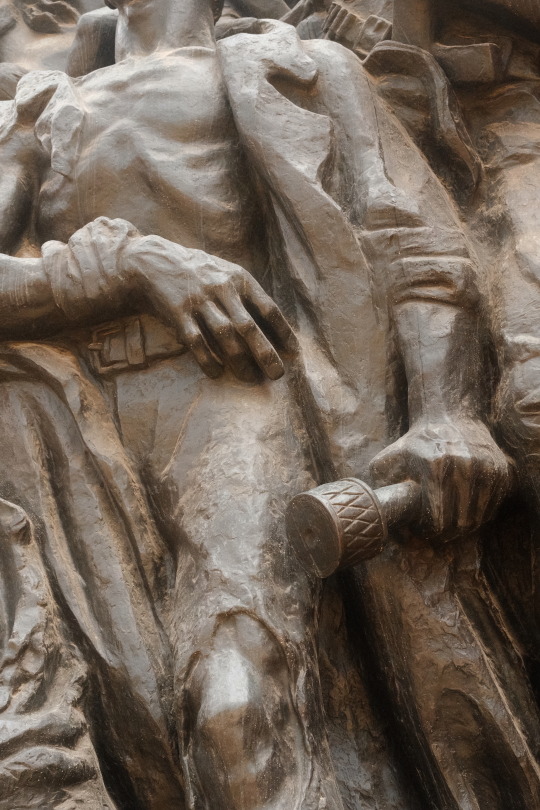

Nathan Rapoport and Leon Suzin, "Monument to the Ghetto Heroes"
Originally completed in Warsaw, 1948; copy installed in Jerusalem, 1976
Photographed at Yad Vashem in Jerusalem, 09.11.22 (Fujifilm X100V)
Warsaw Ghetto Uprising, 19 April - 16 May, 1943
#warsaw ghetto uprising#nathan rapoport#leon suzin#yad vashem#jewish history#jewish art#jumblr#my photo#yidishkeyt#israel
58 notes
·
View notes
Text
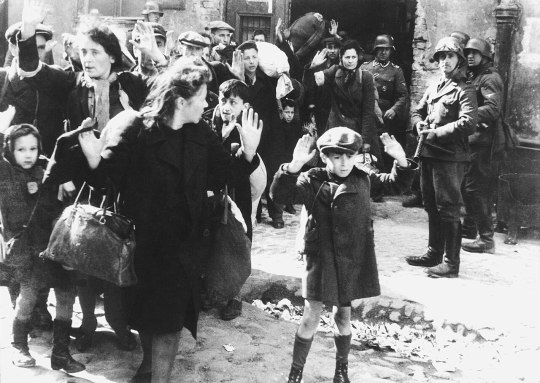
In the best-known photograph taken during the 1943 Warsaw Ghetto Uprising, a boy holds his hands over his head while SS-Rottenführer Josef Blösche points a submachine gun in his direction. Between 19 April 1943 and 16 May 1943
18 notes
·
View notes
Text




"You give us our life; by Your help we survive all who seek our destruction."
– Redemption (Reform Judaism Siddur)
#jewish#judaism#mir veln zey iberlebn#am yisrael chai#am yisra'el ḥay#yom hashoah#warsaw ghetto uprising#id in alt text#never forget#never again#we are still here#non jews can reblog but please be respectful
350 notes
·
View notes
Text
"On the night of April 19 I entered the house at 4 Kurza Street to get flashlights for our men. Wandering about there, I unexpectedly came upon Rabbi Maisel. When I entered the room, I suddenly realized that this was the night of the first Seder.
The room looked as if it had been hit by a hurricane. Bedding was everywhere, chairs lay overturned, the floor was strewn with household objects, the window panes were all gone. It had all happened during the day, before the inhabitants of the room returned from the bunker.
Amidst this destruction, the table in the centre of the room looked incongruous with glasses filled with wine, with the family seated around, the rabbi reading the Haggadah. His reading was punctuated by explosions and the rattling of machine-guns; the faces of the family around the table were lit by the red light from the burning buildings nearby.
I could not stay long. As I was leaving, the Rabbi cordially bid me farewell and wished me success. He was old and broken, he told me, but we, the young people, must not give up, and God would help us.
He also gave me several packages of matzos for my comrades. Should we all survive until morning, he said, I should come again and bring with me Zivia. I fulfilled his wish, and next evening I paid the rabbi another visit, this time in the company of Zivia."
Tuvia Borzykowski, Between Tumbling Walls, 57-18; regarding the night of April 19, 1943: the first full night of the Warsaw Ghetto Uprising, and the first night of Passover.
112 notes
·
View notes
Text

Today marks the 45th anniversary of the death of Cywia Lubetkin - the heroine of the Warsaw Ghetto Uprising and the Warsaw Uprising.
Cywia Lubetkin was born in 1914 in Byteń near Słonim, where she grew up. From 1938 she lived in Warsaw, where she was involved in the activities of the socialist youth organization Dror. After the outbreak of World War II, she made her way from Warsaw to Kowel, which was occupied by the Soviet army, but at the beginning of 1940, at the behest of an organization that lacked proven leaders, she returned to Warsaw.
She was a co-founder of the Anti-Fascist Block, created in the Warsaw Ghetto in the spring of 1942, and a co-organizer of the Jewish Combat Organization, whose shape and policy she had a significant impact on. It was a member of the Jewish National Committee and the Jewish Coordination Commission - an organization associating all groups of the Jewish underground.
She participated in the January self-defense - the first act of armed resistance in the Warsaw Ghetto in January 1943 - and then in the Warsaw Ghetto Uprising. For some time she hid in a bunker at ul. Miła 18, and then she got through the sewers to the "Aryan side". She fought in the Warsaw Uprising in a unit of the People's Army.
After the war, she was active in the Zionist Coordination (Bricha), organizing trips of Jews from Poland, in 1946 she participated in the Zionist Congress and in the same year herself - together with her husband Icchak Cukierman - she lived in Palestine. She was a witness in the trial of Adolf Eichmann in 1961. Involved in the kibbutz movement, she was a co-founder and resident of the Lochamej ha-Getaot (Ghetto Fighters) kibbutz, where she died on July 10, 1978.
Grandchildren of Holocaust Survivors
25 notes
·
View notes
Text
On This Day In History
January 18th, 1943: Jews in the Warsaw Ghetto begin an armed insurgent resistance to their deportation to concentration camps by Nazi Germany.
#history#jewish history#jewish resistance#warsaw ghetto uprising#wwii#tw antisemitism#tw nazi#tw death
43 notes
·
View notes
Text
On the anniversary of the Warsaw Ghetto Uprising:

#warsaw#warsaw ghetto#uprising#161#1312#antifa#anniversary#antiauthoritarian#antinazi#antifascist#antifaschistische aktion#class war#goodnightwhitepride#antiracism#anti capitalism#antifascismo#history#eat the rich#eat the fucking rich#ausgov#politas#auspol#tasgov#taspol#australia#fuck neoliberals#neoliberal capitalism#anthony albanese#albanese government#warsaw ghetto uprising
6 notes
·
View notes
Text
Warsaw Ghetto Uprising
The Warsaw Ghetto, which was the largest ghetto established by the Nazis in Poland, where hundreds of thousands of Jews were confined in overcrowded and unsanitary conditions.
The uprising began on April 19, 1943, when the Nazis attempted to liquidate the ghetto by deporting its remaining inhabitants to concentration camps. Instead of passively submitting to their fate, the Jewish inhabitants…

View On WordPress
#History#Holocaust#Jürgen Stroop#Jewish resistance#Poland#Warsaw Ghetto#Warsaw Ghetto Uprising#World War 2
2 notes
·
View notes